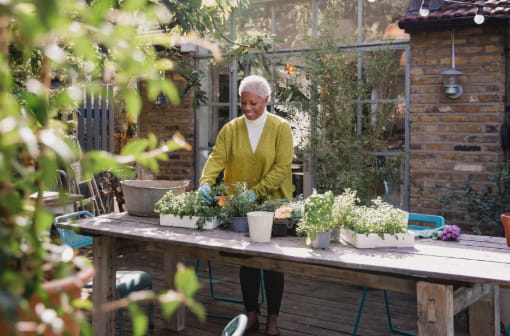“This change is all about supporting Australians to have more, better days at home.”—Amanda Hawton, General Manager, Reform and Insights, Australian Unity
Key points
- The Support at Home program will replace the existing Home Care Packages from late-2025, offering more tailored, flexible support options and increased funding levels.
- The new system encourages earlier, proactive use of services to maintain independence, dignity and real wellbeing at home for longer.
- Support at Home represents a major shift towards better, fairer and more individually targeted aged care in Australia.
Australia’s aged care system is about to undergo its biggest transformation in decades.
From late-2025, the new Support at Home program will replace the current Home Care Package program, offering more personalised care to help people stay independent for longer. It’s a major step towards a more personal aged care system and greater wellbeing for older Australians.
“The Support at Home changes are all about ensuring more Australians have better days at home,” says Amanda Hawton, General Manager of Reform and Insights at Australian Unity. “And that means offering personalised care that preserves dignity, promotes agency, and responds to people’s real needs—as they are today and as they continue to evolve.”
Here’s what changing from the existing Home Care Package program and what you can expect as you move to the new Support at Home program.

Main changes under Support at Home
The existing Home Care Package (HCP) program includes four package levels. Under Support at Home, there will be eight ongoing classifications, plus three short-term pathways, including a dedicated end-of-life care pathway.
This means people will receive care and health support that is tailored to their individual needs.
“Customers will no longer need to fit into rigid boxes,” says Amanda. “The new program offers more targeted, proportionate care, ensuring people get the right level of support at the right time.”
Other new features of the Support at Home program include:
- Quarterly budgets: This is a change from the current annual budgets offered under the Home Care Package program; it helps people use funds more consistently.
- New rules for unspent funds: Participants won’t be able to accumulate unspent funds in the way they do in the Home Care Package program. They can carry over unspent funds from one quarter to the next, but with limits. The maximum amount that can be carried over is $1,000 or 10% of the quarterly budget, whichever is greater. Unspent funds from the old Home Care Package will transition to Support at Home.
- Government-set price caps: From mid-2026 fees will be standardised across all providers and set by the government.
- Streamlined assessments: This makes it faster and easier to access care.
Importantly, the highest funding level will also increase—from approximately $61,440 to $78,000 per year—to help people remain at home for longer, as their needs change.
The program will expand access to care for more Australians, while reducing wait times for services.
“Currently, there are tens of thousands of Australians on the waitlist to access care,” says Amanda. “But by 2027, the target is a three-month waitlist—compared to the typical 18 months or more today.”
She adds that the system aims to support 1.4 million people by 2035, up from almost 300,000 today.
Why is the change happening?
As Amanda explains, the current Aged Care Act, which was introduced in 1997, was built around providers and funding models, instead of the people who were receiving the care.
“The system was never truly centred around older Australians,” she says, “so it was overdue for reform.”
Following the Royal Commission into Aged Care Quality and Safety, the government committed to a ‘person-first’ approach. The new Aged Care Act 2024 enshrines older Australians’ rights in law, and Support at Home is a key part of that shift.
“It’s about dignity, autonomy and independence and making sure more older people can access the care they need in the homes and communities they love.”

Understanding Support at Home package fees and charges
Support at Home will introduce some changes to how funding is structured.
Clinical services—such as nursing, occupational therapy, physiotherapy and counselling—will be fully funded for all participants.
Independence and everyday living services—such as personal care, cleaning, or shopping support—will require a means-tested co-contribution, based on income and assets.
“It’s a partnership—you contribute towards your care, but the services are subsidised,” says Amanda, comparing it to subsidised childcare. “And you get access to a full wraparound team, early interventions and clinical support that really help protect and preserve your wellbeing over time.”
This approach also makes the system more sustainable.
“Aged care is always one of the top four areas of government spending,” says Amanda. “These changes make the system more viable—not just for current customers, but for younger generations too.”
New pricing structure explained
If you currently receive a Home Care Package, you’ll transition into the new system and you will not make higher contributions than you do currently.
Amanda acknowledges that change can be unsettling. “It’s normal to feel unsure,” she says. “That’s why we’re working closely with every Australian Unity customer, offering tailored support throughout the transition.”
Existing Home Care Package customers may also notice changes in how their fees are presented.
Previously, fees were itemised separately, with individual charges for things like package management, travel and service delivery. Under the new program, Support at Home costs will be bundled into one hourly service fee, with one quarterly care management fee—capped at 10%. This does not include home modifications and mobility aids.
“This might initially cause some concern, because hourly rates could appear higher at first glance,” acknowledges Amanda. But overall, she says, most customers will pay roughly the same as they do now.
“You won’t be paying separate package management and travel fees, and care management will be capped at 10 percent per quarter. So, the pricing is simply being shown in a different way.”

What’s changing with unspent funds?
Historically, many customers have accumulated large reserves of unspent funds under the Home Care Package program.
“Culturally, Australians have a ‘she’ll be right’ mindset and a preference to save up their money for a really rainy day,” Amanda says. “But the downside is that this can lead to ‘soldering on’ and service avoidance, which means they often don’t access the care they need because they’re waiting for things to get worse.”
Under Support at Home, the amount of unspent funds that you will be able to carry over each quarter will be capped at up to 10 percent of your quarterly budget or $1,000, whichever is greater.
“This is about encouraging people to invest in themselves now and to take more of a preventative approach,” explains Amanda. “Early care is better care, so don’t wait until you’re in crisis.”
Australian Unity is here to help
As one of Australia’s largest home care providers, Australian Unity is committed to guiding both existing and new customers through the transition.
“We’re leaving no stone unturned,” says Amanda. “We’re mobilising our whole team to ensure that support continues seamlessly and that every customer feels heard, safe and supported.”
As always, Australian Unity will continue to prioritise early intervention, continuity of care and Real Wellbeing.
“Our frontline teams aren’t just delivering services—they’re trained to notice subtle changes in a customer’s health or behaviour, and to alert their care partner,” explains Amanda. “That way, we can respond early and adjust care before problems escalate.”
This kind of “wraparound support” is what makes Australian Unity’s approach truly valuable, she says.
“Rather than having multiple providers come and go, we build a complete picture of the customer’s needs and stay with them through every stage.”

Here’s to a better future for aged care
Support at Home represents a major shift towards better, fairer and more individually targeted aged care in Australia.
While change can feel daunting, Amanda is confident that this is a positive step forward.
“We’re not just helping people live longer,” she says. “We’re helping them live better—with dignity, with independence, and with real wellbeing at the heart of every decision.”
Feeling uncertain? You're not alone
If you’re feeling anxious about the change, help is available.
“Talk to your care partner or provider,” urges Amanda. “If you’re unsure about anything, reach out to us. Let’s walk through it together.”
Independent advocacy is also available via the Older Persons Advocacy Network (OPAN), and regular updates can be found on the Support at Home and Aged Care Act government websites.
Find out more about home care services with a difference


